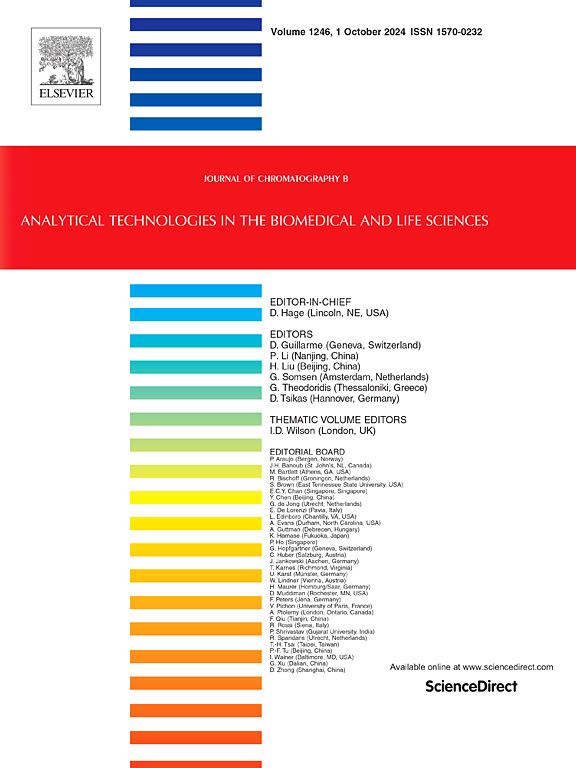LC-MS/MS测定大气颗粒物中7种1-苯基-2-丙烷前体物质:一种监测非法药物合成和评估潜在健康风险的新策略
IF 2.8
3区 医学
Q2 BIOCHEMICAL RESEARCH METHODS
引用次数: 0
摘要
在非法药物生产和制造过程中,一些前体可能逃逸到空气中并附着在空气中的颗粒物表面。在疑似药物制造设施附近的大气颗粒物质中探测前体物质,可有助于推断药物合成途径并从源头上减少非法药物制备。近年来,甲基苯丙胺的合成已从以麻黄碱/伪麻黄碱为基础的途径显著过渡到以1-苯基-2-丙烷(P2P)为基础的途径,这突显了P2P及其前体化学品在监测和控制非法药物制造方面日益重要。本研究采用大气颗粒物采样器对大气颗粒物进行富集,并采用湿磨法对样品进行处理。建立了液相色谱-串联质谱法(LC-MS/MS)定量检测7种P2P前体物质的方法。结果表明,7种P2P前体物质的检出限在0.20 ~ 0.50 ng/mL范围内,线性相关系数(r)均大于0.9940。3个加标水平下的基质效应和加标回收率分别为92.1% ~ 107.4%和94.0% ~ 105.2%。利用该方法从实验室采集实际样品,在体外样品称重室检测3-氧-2-苯基丁烷酰胺(APAA),在采集第一天检测浓度为91.5 pg/m3。结果表明,室内人员APAA的最大可能日吸入剂量为1.83 × 10 - 6 mg。随后,拟合了浓度与收集日期相关的非线性函数,为打击P2P合成甲基苯丙胺的非法制备奠定了研究基础,并突出了禁毒人员的职业暴露和高浓度与毒品有关的大气颗粒物对附近居民的健康威胁。本文章由计算机程序翻译,如有差异,请以英文原文为准。
Determination of seven precursor substances of 1-phenyl-2-propanone in atmospheric particulate matter by LC-MS/MS: A novel strategy for monitoring illicit drug synthesis and assessing potential health risks
In the process of illicit drug production and manufacture, some of the precursors might escape into the air and adhere to the surface of airborne particulate matter. The detection of precursor substances in atmospheric particulate matter in the vicinity of suspected drug manufacturing facilities can assist in the deduction of drug synthesis pathways and the reduction of illicit drug preparation at the source. In recent years, there has been a notable transition in methamphetamine synthesis from the ephedrine/pseudoephedrine-based route to the 1-phenyl-2-propanone (P2P)-based route, underscoring the growing significance of P2P and its precursor chemicals in the surveillance and control of illicit drug manufacturing. In this study, airborne particulate matter was enriched using an atmospheric particulate matter sampler, and the samples were processed by wet milling method. A quantitative method for the detection of seven precursor substances of P2P was established by liquid chromatography-tandem mass spectrometry (LC-MS/MS). The results showed that the limits of detection for the seven precursor substances of P2P were in the range of 0.20–0.50 ng/mL, and the linear correlation coefficients (r) were all greater than 0.9940. The matrix effects and recovery at three spiked levels were in the ranges of 92.1 %–107.4 % and 94.0 %–105.2 %, respectively. Utilising this method to collect the actual samples from the laboratory, 3-oxo-2-phenylbutanamide (APAA) was detected in the in vitro sample weighing room and was identified at a concentration of 91.5 pg/m3 on the initial day of collection. It was determined that the maximum possible daily inhalation dose of APAA for room occupants was 1.83 × 10−6 mg. Subsequently, a nonlinear function correlating concentration and collection date was fitted, laying the research foundation for combating the illicit preparation of methamphetamine synthesised via P2P and highlighting the occupational exposure of anti-drug personnel and health threat to nearby residents due to high-concentration, drug-related atmospheric particulate matter.
求助全文
通过发布文献求助,成功后即可免费获取论文全文。
去求助
来源期刊

Journal of Chromatography B
医学-分析化学
CiteScore
5.60
自引率
3.30%
发文量
306
审稿时长
44 days
期刊介绍:
The Journal of Chromatography B publishes papers on developments in separation science relevant to biology and biomedical research including both fundamental advances and applications. Analytical techniques which may be considered include the various facets of chromatography, electrophoresis and related methods, affinity and immunoaffinity-based methodologies, hyphenated and other multi-dimensional techniques, and microanalytical approaches. The journal also considers articles reporting developments in sample preparation, detection techniques including mass spectrometry, and data handling and analysis.
Developments related to preparative separations for the isolation and purification of components of biological systems may be published, including chromatographic and electrophoretic methods, affinity separations, field flow fractionation and other preparative approaches.
Applications to the analysis of biological systems and samples will be considered when the analytical science contains a significant element of novelty, e.g. a new approach to the separation of a compound, novel combination of analytical techniques, or significantly improved analytical performance.
 求助内容:
求助内容: 应助结果提醒方式:
应助结果提醒方式:


